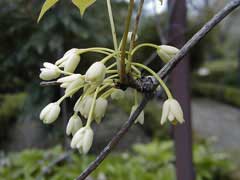 |
|
http://commons.wikimedia.org/wiki/User:Cillas |
 |
|
Translate this page:
Summary
Physical Characteristics

 Holboellia coriacea is an evergreen Climber growing to 7 m (23ft) at a fast rate.
Holboellia coriacea is an evergreen Climber growing to 7 m (23ft) at a fast rate.
See above for USDA hardiness. It is hardy to UK zone 9. It is in leaf all year, in flower from April to May, and the seeds ripen from July to September. The species is monoecious (individual flowers are either male or female, but both sexes can be found on the same plant).
Suitable for: light (sandy), medium (loamy) and heavy (clay) soils. Suitable pH: mildly acid, neutral and basic (mildly alkaline) soils. It can grow in full shade (deep woodland) semi-shade (light woodland) or no shade. It prefers moist soil.
UK Hardiness Map
US Hardiness Map
Synonyms
Plant Habitats
Woodland Garden Sunny Edge; Dappled Shade; Shady Edge;
Edible Uses
Edible Parts: Fruit
Edible Uses:
Fruit - raw[3]. Sweet but insipid[109, 183]. The fruit is purple with a white pulp and is about 5cm long and 2.5cm wide[183].
References More on Edible Uses
Medicinal Uses
Plants For A Future can not take any responsibility for any adverse effects from the use of plants. Always seek advice from a professional before using a plant medicinally.
None known
References More on Medicinal Uses
The Bookshop: Edible Plant Books
Our Latest books on Perennial Plants For Food Forests and Permaculture Gardens in paperback or digital formats.

Edible Tropical Plants
Food Forest Plants for Hotter Conditions: 250+ Plants For Tropical Food Forests & Permaculture Gardens.
More

Edible Temperate Plants
Plants for Your Food Forest: 500 Plants for Temperate Food Forests & Permaculture Gardens.
More

More Books
PFAF have eight books available in paperback and digital formats. Browse the shop for more information.
Shop Now
Other Uses
References More on Other Uses
Cultivation details
Easily grown in any fertile soil in sun or part shade[182, 200]. Plants grow best on a shady wall or when grown into a tree[200]. They succeed in sun or deep shade, but fruits are much more likely to be produced when the plants are grown in a sunny position[200, 219]. Plants are not fully hardy in Britain, they tolerate temperatures down to about -15°c[184] and can be damaged by prolonged periods below -5°c[200]. Plants are hardy at Kew but they do not fruit freely in this country[11]. Hand pollination would probably help[11, 166], the fruits are also more likely to form in hot summers[166]. There is also some doubt as to whether the plants are monoecious or dioecious, it would be best to grow at least two distinct plants (not cuttings from one plant) and make sure that male and female flowers are present[K]. The flowers are sweetly and heavily scented. The males are produced on the previous years wood whilst females are produced on the current years wood[182]. Plants are fast growing[200] and climb by means of twining[182]. This genus is closely related to Stauntonia species[200].
References Carbon Farming Information and Carbon Sequestration Information
Temperature Converter
Type a value in the Celsius field to convert the value to Fahrenheit:
Fahrenheit:
The PFAF Bookshop
Plants For A Future have a number of books available in paperback and digital form. Book titles include Edible Plants, Edible Perennials, Edible Trees,Edible Shrubs, Woodland Gardening, and Temperate Food Forest Plants. Our new book is Food Forest Plants For Hotter Conditions (Tropical and Sub-Tropical).
Shop Now
Plant Propagation
Seed - we have no details on this species but suggest sowing the seed as soon as it is ripe if this is possible, otherwise as soon as you obtain it, in a warm greenhouse. When they are large enough to handle, prick the seedlings out into individual pots and grow them on in the greenhouse for at least their first winter. Plant them out into their permanent positions in late spring or early summer, after the last expected frosts. Cuttings of softwood[1]. Cuttings of half-ripe wood in late summer or autumn[188]. Layering.
Other Names
If available other names are mentioned here
Native Plant Search
Search over 900 plants ideal for food forests and permaculture gardens. Filter to search native plants to your area. The plants selected are the plants in our book 'Plants For Your Food Forest: 500 Plants for Temperate Food Forests and Permaculture Gardens, as well as plants chosen for our forthcoming related books for Tropical/Hot Wet Climates and Mediterranean/Hot Dry Climates. Native Plant Search
Found In
Countries where the plant has been found are listed here if the information is available
Weed Potential
Right plant wrong place. We are currently updating this section.
Please note that a plant may be invasive in one area but may not in your area so it’s worth checking.
Conservation Status
IUCN Red List of Threatened Plants Status :

Growth: S = slow M = medium F = fast. Soil: L = light (sandy) M = medium H = heavy (clay). pH: A = acid N = neutral B = basic (alkaline). Shade: F = full shade S = semi-shade N = no shade. Moisture: D = dry M = Moist We = wet Wa = water.

Expert comment
Author
Diels.
Botanical References
11200266
Links / References
For a list of references used on this page please go here
Readers comment